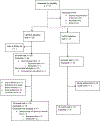Changes in hair cortisol concentration in intrauterine device initiators: A prospective cohort study
- PMID: 37633589
- PMCID: PMC10842525
- DOI: 10.1016/j.contraception.2023.110142
Changes in hair cortisol concentration in intrauterine device initiators: A prospective cohort study
Abstract
Objectives: Prior studies found increased hair cortisol concentration (a surrogate marker for hypothalamic-pituitary-adrenal axis activation) in users of the levonorgestrel intrauterine device (LNG 52 mg IUD). We evaluated change in hair cortisol and psychometric tests in women initiating a copper (CuT380 IUD) or LNG 52 mg IUD.
Study design: We prospectively enrolled healthy women initiating an LNG 52 mg IUD or CuT380 IUD. Participants provided hair and blood samples and completed psychometric inventories (Patient Health Questionnaire-9, Positive and Negative Affect Schedule, and Psychological General Well-Being Index) after IUD insertion and at 6 and 12 months. We used liquid chromatography with tandem mass spectrometry to measure hair cortisol concentrations. We compared hair cortisol concentrations and psychometric test changes from baseline to 6 and 12 months using independent two-sample t tests.
Results: We enrolled 39 of our targeted 86 participants (LNG 52 mg IUD 26, CuT380 IUD 13). Thirty-eight subjects (LNG 52 mg IUD 25, CuT380 IUD 13) completed 6 months of follow-up. We found no difference between cohorts in the mean change in hair cortisol concentrations at 6 months (LNG 52 mg IUD n = 21 [-0.01 pg/mg (95% CI -1.26, 1.23); CuT380 IUD n = 13 [-1.31 pg/mg (-3.36, 0.73)]). While psychometric inventory results remained within normal ranges, LNG 52 mg IUD users reported a trend toward more favorable changes over time.
Conclusions: We did not find clinically important differences in hair cortisol concentrations following initiation of a CuT380 IUD or LNG 52 mg IUD; psychometric inventories demonstrated no adverse effect of hormonal IUDs on mood.
Implications: Our findings of similar hair cortisol concentrations following the initiation of either the LNG 52 mg IUD or CuT380 IUD suggest that hormonal IUDs do not increase cortisol concentrations or alter stress reactivity, and favorable effects on psychometric inventories provide further reassurance that the LNG 52 mg IUD has no adverse impact on mood.
Trial registration number: ClinicalTrials.gov NCT03499379.
Keywords: Cortisol; IUD; Intrauterine device; Mood; Stress.
Copyright © 2023 Elsevier Inc. All rights reserved.
Conflict of interest statement
Figures
Similar articles
-
The levonorgestrel-releasing intrauterine device potentiates stress reactivity.Psychoneuroendocrinology. 2017 Jun;80:39-45. doi: 10.1016/j.psyneuen.2017.02.025. Epub 2017 Feb 28. Psychoneuroendocrinology. 2017. PMID: 28315609
-
Safety and continued use of the levonorgestrel intrauterine system as compared with the copper intrauterine device among women living with HIV in South Africa: A randomized controlled trial.PLoS Med. 2020 May 22;17(5):e1003110. doi: 10.1371/journal.pmed.1003110. eCollection 2020 May. PLoS Med. 2020. PMID: 32442189 Free PMC article. Clinical Trial.
-
Menstrual characteristics and ultrasonographic uterine cavity measurements predict bleeding and pain in nulligravid women using intrauterine contraception.Hum Reprod. 2015 Jul;30(7):1580-8. doi: 10.1093/humrep/dev102. Epub 2015 May 19. Hum Reprod. 2015. PMID: 25990577
-
An evaluation of the levonorgestrel-releasing IUD: its advantages and disadvantages when compared to the copper-releasing IUDs.Contraception. 1991 Dec;44(6):573-88. doi: 10.1016/0010-7824(91)90078-t. Contraception. 1991. PMID: 1773615 Review.
-
Intrauterine devices. The optimal long-term contraceptive method?J Reprod Med. 1999 Mar;44(3):269-74. J Reprod Med. 1999. PMID: 10202746 Review.
References
-
- Sivin I, el Mahgoub S, McCarthy T, Mishell DR Jr., Shoupe D, Alvarez F, et al. Long-term contraception with the levonorgestrel 20 mcg/day (LNg 20) and the copper T 380Ag intrauterine devices: a five-year randomized study. Contraception. 1990;42(4):361–78. doi: 10.1016/0010-7824(90)90046-x - DOI - PubMed
Publication types
MeSH terms
Substances
Associated data
Grants and funding
LinkOut - more resources
Full Text Sources
Medical


